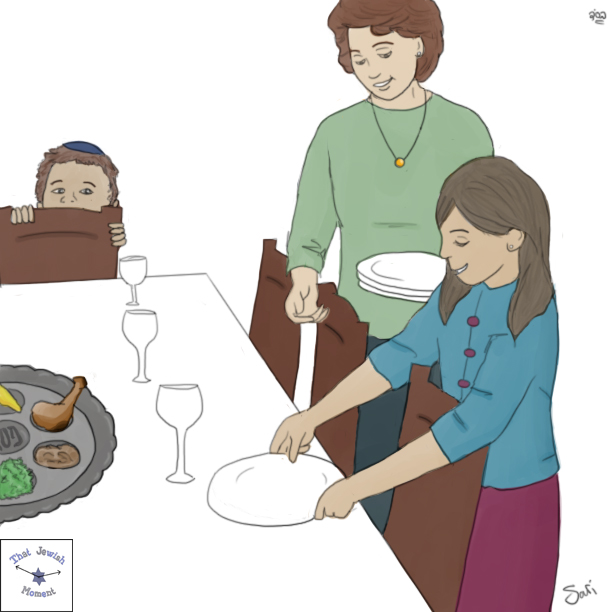
When I was a kid, one of the early indications of the great importance of Pesach was that a couple of weeks before Yom Tov my grandmother would go to the basement to take inventory of her Pesach products and dishes/utensils. This was remarkable not for the work which was accomplished, but for the fact that she walked down the stairs.
From the time I was a small child, my Bubby suffered from crippling arthritis. Her mobility was very limited, and she used a walker.
She almost never went to the basement. So when she took her annual trip down the stairs, it left an impression. It meant that Pesach was serious business.
Steps were a particular challenge for her. While she continued to sleep in a second-floor bedroom until the last year or so of her life (she died shortly after my 20th birthday), she almost never went to the basement. So when she took her annual trip down the stairs, it left an impression. It meant that Pesach was serious business.
The selection of kosher l’Pesach foods has always been limited in Charleston, West Virginia, where I grew up, so for years my grandparents made an annual pilgrimage to Cincinnati in the month before Pesach to visit my aunt and go shopping. Meats and cheeses went in the basement fridge or back porch freezer, and nonperishable items were laid out on a ping pong table that Zayde set up in the basement.
The Pesach dishes were also stored in a large cabinet with a barrel bolt lock in the basement (never to be touched during the year), and a week or two before Yom Tov, they were taken out to be washed over the laundry sink—a job that usually fell to my mother.
Even though she was no longer able to perform some of the labor associated with the holiday, Bubby was still in charge. Her foray into the cellar, which lasted an hour or so, enabled her to take stock of everything and let the family members know which utensils were needed first to begin food preparations. Eventually, the dishes would be brought upstairs and stored in the pantry on a counter top and in a freestanding cabinet that Zayde brought down from the attic each year.
As a kid, I had some modest responsibilities leading up to the chag, such as dusting shelves of knick knacks and setting the table on the seder nights, but the anticipation, and watching as older family members brought out the Pesach dishes and foods, was very exciting. As my sister and I grew older, we helped bring items up or down stairs, and we were annually warned to be careful, and then reminded of the time, long before we were born, when Zayde had accidentally dropped a whole stack of plates on the stairs, breaking them.

These memories flood back every year as I set up folding tables in my basement to hold the foods I have purchased and the dishes, pots, pans and utensils which will soon be brought out of plastic bins and cardboard boxes. The Pesach cabinet that Zayde always brought down from the attic is now stored in my basement, more than 200 miles away from their old Quarrier Street house. I don’t have space for it in my kitchen, so it stays in the basement all year. However, it is still designated for Pesach use, and now holds haggadahs, glassware, spices and a variety of other holiday necessities.
Pesach celebrates the redemption of the Jewish people from Egypt, which enabled us to solidify our national identity, begin the journey to receive the Torah and, more than 40 years later, enter the land of Israel. It is the critical story of our people-hood. The story of Yetzias Mitzrayim is one which captures our imaginations not just once a year, but throughout the year, and in our daily prayers.
And so, I guess it makes sense that it takes, on average, about a month of gradual preparations to get one’s home and one’s heart ready to spiritually experience Yetzias Mitzrayim again.
The rabbi of my shul in Pittsburgh, Rabbi Daniel Wasserman, gives an annual sermon a few weeks before Pesach in which he reiterates the importance of removing chametz from our homes. While this process can be arduous, he reminds us that we should find it “ennobling”.
I doubt that Bubby would have described her Pesach preparations as ennobling—she did not mince words in noting that Pesach places extraordinary burdens on women—but she also took these responsibilities upon herself without complaint. Despite her physical limitations, she continued to do the majority of her household cleaning by herself.
She took great pride in having a home that was clean and orderly, and preparing delicious meals that were more than just physically nourishing. On the seder nights, she was exhausted, but full of laughter and pride.
Without days or weeks of effort, planning and exertion, Pesach would not have the same level of anticipation and excitement. The chag is the goal, but the process of preparing is half the journey.
At the seders, my grandparents would often tell stories about their parents’ observance of Pesach—the songs they sang, the foods their mothers prepared, how or where they obtained matzah, wine and kosher meat in the towns where they lived. (Bubby’s parents made their own wine, even during Prohibition.) As we retold the national narrative of the Jewish people, they were also transmitting our family narrative, an informal practice which is part and parcel of the seder experience for many, if not most, Jewish families.
As the days leading up to this year’s Pesach unfold, I am tired, absentminded and anxious about forgetting important details. Every time I check things off my long to-do lists, I think of several more things that must get done. It’s overwhelming, but it’s also deeply meaningful.
Returning to the rabbi’s drasha about the cleaning being “ennobling”, I have come to realize that it is satisfying to work for a holiday whose practice is festive…and even magical. Educators these days talk about “experiential learning”, which is learning through doing. In a lot of ways, the seder itself is experiential learning, but I’ve come to realize that the cleaning is too. It’s the physical application of a spiritual task. Without days or weeks of effort, planning and exertion, Pesach would not have the same level of anticipation and excitement. The chag is the goal, but the process of preparing is half the journey.
And, of course, Pesach is inescapably about family: family members working together to create a special holiday atmosphere, and passing down family recipes, memories and jokes.
With unleavened bread and simple ingredients, we create a little bit of magic, just at the time that spring is magically transforming our world from brown to vibrant color.
Last year, while I was in the basement, cleaning and reorganizing to make space for all of my Pesach products, my kids came down out of curiosity to see what was going on. Instead of complaining they were bored or begging for screen time, they stayed close by, playing with their art supplies and talking about the foods they were looking forward to eating on Pesach.
As the chag approached, I gave them small jobs to do. This year, I’ll ask them to help more, and in future years, their responsibilities will increase. For now, though, I am heartened to see them curious about how we prepare for Pesach. Bubby and Zayde would be proud.